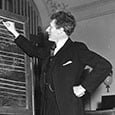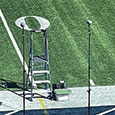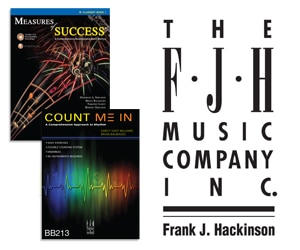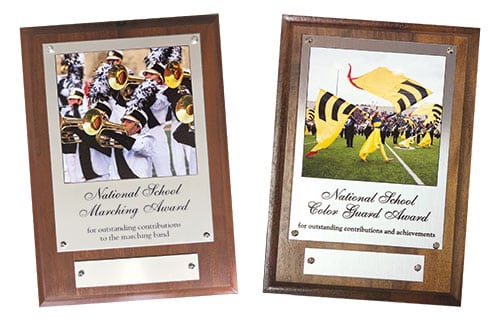Originally published: Sept/Oct 1949

We are told that Adolph Sax created the saxophones with the definite intention of providing a group of instruments midway in tonal strength between the weaker sonorities of the reeds and the stronger sonorities of the brass. This office the saxophone family most satisfactorily performs – that is to say, as long as the family is complete and tonally well-balanced within itself. It is obvious that if the soprano saxophone is missing, the tone-strength gap between the oboe and the cornet will be unfilled, and that Adolph Sax’s laudable intention (of providing a delicately gauged transition from weaker to stronger instruments within each register) will be frustrated in the soprano tonal area. Likewise, if the baritone saxophone be missing, the midway tone-strength between the bassoon and the trombone will be lacking and Sax’s subtle scheme brought to nought in the bass tonal area.
Balance of Tone
As regards the balance of tone within the saxophone family itself, as intended by Sax: It is obvious that planless aggregations of saxophones, such as are all too often encountered in carelessly organized bands – say 6 altos, 3 tenors, and 1 baritone – can never produce a good balance of tone. And one cannot but wonder what it is that makes budding saxophonists so unreasonably inclined to mass on one or two voices of an instrumental family, every member of which is amenable and highly rewarding to play – a family, moreover; in which the changing from one voice to another is singularly easy and convenient.
I think this tendency to mass upon the alto and tenor saxophones and to neglect the other members of the family is the result of an old-fashioned “soloistic” view of music and an inability to grasp the chief advantage to be gained from band playing, which latter is rich harmonic experience.
Harmonic Experience in Band
Band conductors fail in their esthetic duty if they do not impress upon band members an understanding of the major role played by harmony in all types of art-music from the 13th century onward – whether the 500 years of exquisite church music that preceded Bach; whether the great giants of the “classical” and “romantic” periods, such as Beethoven, Schubert, Wagner, Brahms, or Cesar Franck; whether the tonal harmonies of Arnold Schoenberg or the rich expressiveness of American jazz and swing harmonies.
Need of Complete Family
Band conductors also should be able to convince saxophone players of the utter necessity of maintaining a complete saxophone family in each band. As a soloist, a player may justifiably prefer one saxophone voice to another, but band leaders must prevent this soloistic viewpoint from playing havoc with the effectiveness of the saxophone group as a whole and of the band as a whole.
The neglect of the soprano saxophone is an extraordinary example of musical shortsightedness; for what is any family of instruments without its soprano? What would the brass section be without cornets or What would a choir of voices be without its sopranos? What would a string quartet be without its first violin? There are differences of opinion concerning the tonal quality of the soprano saxophone. Personally, I consider it the most beautiful and characteristic voice of the entire saxophone family. It has a rich bucolic timbre that enables it to take, in the band, a place similar to that occupied by the oboe in the orchestra.
In passing, it may be remarked that the oboe plays a very different role in the band from that which it does in the orchestra. In the orchestra it gives the impression of great intensity and considerable prominence – owing to the gentle tonal background of the strings. In the band, the oboe sounds much thinner – and produces an impression of distance and frailty – owing to the larger number of brass instruments and the massing of clarinets. This is where the soprano saxophone, with its stronger-than-oboe sonority, is able to prove its unique value in the band – as a kind of band oboe.)
Ensembles and Pre-Bach Music
Adolph Sax was deeply wise in arranging the tonal ranges of his saxophone voices in conformity with the vocal ranges – the soprano saxophone covering the range of the soprano voice, the tenor saxophone covering the range of the tenor voice, and so on. Because of Sax’s foresight in this particular, it is possible for saxophone ensembles to play, without rearrangement, the entire vocal polyphonic literature of the Christian Church from the 13th century up to and including Bach. This embraces the finest works of such giants as Guillaume de Machant, Guillaume Dufay, Bedyngham, John Dunstable, Josquin des Prez, Antonio de Cabezon, Adrian Willaert, Claude Le Jeune, John Jenkins, Alfonzo Ferrabosco, and many others. These masterworks sound as satisfying on saxophone groups as they do on the voices for which they were originally written.
Roots of Saxophone Popularity
The world-wide and ever-growing popularity of the saxophone must, I think, be considered part of that great revival of interest in melody that characterizes our century. For just as the zenith of interest in technical display – on the voice, the piano, the violin, etc. – must be placed in the 19th century, so the 20th century may be described as a period of vital concern with every type of melodiousness: In Gregorian chant, in primitive music, in folksong, and in polyphonic melodiousness (as in Vaughan Williams, for instance). There is some connection between what we call “melody” (as distinct from “tune,” “theme,” “motive”) and the human voice; in fact, true melody may be described as “that kind of music which naturally suits the human voice.” Since the saxophones are pehaps the most voice-like of all musical instruments, it naturally follows that they have a great role to play in the present-day revival of interest in melodiousness.
Music Trends and World Peace
In every age there appears to be some main urge behind the combined activities of humanity. There is little doubt in my mind that in our age the main urge behind all humanity is a longing and striving for world peace. Musically speaking, this urge seems to me to manifest itself not only in the yearning soulfulness and affectionate emotionalism of the greatest composers of our era (men such as Frederick Delius, Sibelius, Cyril Scott, Herman Sandby, Sparre Olsen, Arthur Fickenscher, George Gershwin and Duke Ellington), but also in the current fondness shown for sustained, singing, emotionally expressive instruments such as the saxophones. The war-loving periods of Frederick the Great and Napoleon were heralded by the war-like music of Bach (Brandenburg Concertos), Haydn, Mozart, Beethoven and Rossini – music in which militaristic fanfares, march-like drum-beating and mass-dragooned rhythms prevail. This war-attuned musical trend swayed the “military” band in its early days, to which band programs of the last century clearly attest. But what a change has come over band music and band programs in our lifetime! The band has become the vehicle par excellence for music of a peaceable, loving, yearning, intimate nature. Think of the English Folksong Suite of Vaughan Williams, the Suite Francaise of Darius Milhaud, the Shoonthree of Henry Cowell.
To this deepening and beautifying of the band’s message, the saxophone family (with its yearning voices, its exquisitely balanced harmonies, heart-throb sonorities) has most valuably contributed. This, in my opinion, is the main office of the saxophone family in the military band: To refine our emotional susceptibilities, thereby making music-lovers (and perhaps mankind in general) more receptive to all those delicate stirs that make for world-peace and for a gentler and happier life on this globe.
It may sound fantastic, to many readers, to wish to trace some connection between music and world trends. On the other hand, there must be some deep-rooted instinct abroad in humanity today that makes it willing and anxious to spend so much time and money upon the art of music.
I have noticed that those who attempt to ascribe world trends to economic factors are usually unable to foretell human history at all accurately, while philosophers like Cyril Scott – who take a soulful or esoteric view of life – seem much cleverer at being able to forecast world movements and events before they happen. Is this, perhaps, because we live in a subtle rather than in a simple world – a world in which the underlying forces are emotional rather than materialistic?





